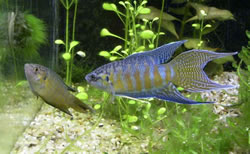 For peace and harmony to prevail inside your aquarium tank, make sure you put in fish species that are compatible. Like other animals, some species of fish are more aggressive and predatory, while some possess a naturally calm temperament. If you are in the process of selecting compatible fish species for your community tank, here are some tips to help you:
For peace and harmony to prevail inside your aquarium tank, make sure you put in fish species that are compatible. Like other animals, some species of fish are more aggressive and predatory, while some possess a naturally calm temperament. If you are in the process of selecting compatible fish species for your community tank, here are some tips to help you:
Know the Basic Categories of Tropical fish
The basis of these categories is their ability to get along well with other fish in the tank.
- Category 1 - Community fish
This is the largest group of tropical fish species; those that belong to this category don’t grow larger than two to three inches. Some common community tropical fish species include tetras, guppies, danios, swordtails, mollies, and platies. It is recommended to keep at least three to five of their own species when placing them in your tank. - Category 2 - Semi-aggressive fish species
This group includes gouramis, loaches, eels, and sharks. Males of the species have higher tendencies of displaying aggression toward other tank inhabitants and often become territorial. Since most of these species can grow larger than most community fish, they should be kept in 29-gallon tanks or bigger. If you are thinking of putting some semi-aggressive species in your tank, add a number of peaceful community fish to balance out the tank. When community and semi-aggressive fish are placed together, make sure there is no major size difference between species, since larger semi-aggressive species may bully your smaller community fish. - Category 3 - Very Aggressive Tropical Fish Species
Most members of this category are large fish species that include cichlids and oscars. Plecostomus and other types of catfish can also become quite aggressive. In most instances, tropical fish species that are very aggressive cannot be mixed with community fish and even semi-aggressive species. One important contributory factor is the major difference in their sizes.
Aggressive fish species are not recommended for newbies since they have specific requirements that beginners may find difficult to meet.
Know How to Mix Different Species Safely
Avoid keeping more than one male of a species in the same tank. Although this may not be an issue in small community fish, you should bear this in mind when mixing semi-aggressive and aggressive species. You should also consider the adult size of the fish. Bullying can cause stress, and the weaker one could eventually die if not removed immediately from the tank. Small community fish can also become tasty meals for larger semi-aggressive fish.
Provide places to hide in inside the tank
Occasionally, one of the fish in your peaceful community tank may cause trouble and bully other tank inhabitants. Providing places to hide in, such as live or aquatic plants, rock caves, overturned clay pots, and large shells provide great hiding places for fish.
Introduce one species at a time
It is not advisable to dump all of your fish into the tank at the same time. It is best to introduce each species one at a time to give them a chance to adjust to the tank before another species is added.
About the Author:
Peter Hartono is the founder and CEO of Just Aquatic - a proud Australian company that offers homegrown aquatic plants and aquarium supplies carrying top of the line brands including API, biOrb and Exo Terra. To find out more of our exciting offers and promotions check out our Facebook Page and follow us on Twitter at @justaquatic.

